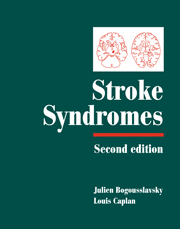Book contents
- Frontmatter
- Contents
- List of contributors
- Preface
- PART I CLINICAL MANIFESTATIONS
- 1 Stroke onset and courses
- 2 Clinical types of transient ischemic attacks
- 3 Hemiparesis and other types of motor weakness
- 4 Sensory abnormality
- 5 Cerebellar ataxia
- 6 Headache: stroke symptoms and signs
- 7 Eye movement abnormalities
- 8 Cerebral visual dysfunction
- 9 Visual symptoms (eye)
- 10 Vestibular syndromes and vertigo
- 11 Auditory disorders in stroke
- 12 Abnormal movements
- 13 Seizures and stroke
- 14 Disturbances of consciousness and sleep–wake functions
- 15 Aphasia and stroke
- 16 Agitation and delirium
- 17 Frontal lobe stroke syndromes
- 18 Memory loss
- 19 Neurobehavioural aspects of deep hemisphere stroke
- 20 Right hemisphere syndromes
- 21 Poststroke dementia
- 22 Disorders of mood behaviour
- 23 Agnosias, apraxias and callosal disconnection syndromes
- 24 Muscle, peripheral nerve and autonomic changes
- 25 Dysarthria
- 26 Dysphagia and aspiration syndromes
- 27 Respiratory dysfunction
- 28 Clinical aspects and correlates of stroke recovery
- PART II VASCULAR TOPOGRAPHIC SYNDROMES
- Index
- Plate section
28 - Clinical aspects and correlates of stroke recovery
from PART I - CLINICAL MANIFESTATIONS
Published online by Cambridge University Press: 17 May 2010
- Frontmatter
- Contents
- List of contributors
- Preface
- PART I CLINICAL MANIFESTATIONS
- 1 Stroke onset and courses
- 2 Clinical types of transient ischemic attacks
- 3 Hemiparesis and other types of motor weakness
- 4 Sensory abnormality
- 5 Cerebellar ataxia
- 6 Headache: stroke symptoms and signs
- 7 Eye movement abnormalities
- 8 Cerebral visual dysfunction
- 9 Visual symptoms (eye)
- 10 Vestibular syndromes and vertigo
- 11 Auditory disorders in stroke
- 12 Abnormal movements
- 13 Seizures and stroke
- 14 Disturbances of consciousness and sleep–wake functions
- 15 Aphasia and stroke
- 16 Agitation and delirium
- 17 Frontal lobe stroke syndromes
- 18 Memory loss
- 19 Neurobehavioural aspects of deep hemisphere stroke
- 20 Right hemisphere syndromes
- 21 Poststroke dementia
- 22 Disorders of mood behaviour
- 23 Agnosias, apraxias and callosal disconnection syndromes
- 24 Muscle, peripheral nerve and autonomic changes
- 25 Dysarthria
- 26 Dysphagia and aspiration syndromes
- 27 Respiratory dysfunction
- 28 Clinical aspects and correlates of stroke recovery
- PART II VASCULAR TOPOGRAPHIC SYNDROMES
- Index
- Plate section
Summary
Epidemiologic aspects of stroke-related disability
At the dawn of the new Millennium, with specific effective therapies for the treatment of acute ischemic stroke still unavailable, we are witnessing in industrialized countries a significant decrease in stroke mortality accompanied by a rising total prevalence of this disease (Warlow, 1998). This observation may be related to an improved survival, rather than to the declining incidence of stroke. Accordingly, the number of patients with stroke-related disabilities may be twice as high as was previously thought (Geddes et al., 1996).
Of all patients alive 6 months after an ischemic event, about 30% are dependent for their primary activities of daily living (ADL) (Bernspång et al., 1987; Ahlsïo et al., 1984; Warlow, 1998), while approximately 60% are expected to recover independence with self-care. Institutional care is common during the first months after stroke (around 20%), decreasing progressively because of high case fatality among the most severe patients (Jongbloed, 1986; Strand et al., 1985).
Thus, most of the staggering economic costs related to stroke are not due to acute hospitalization, but to postacute rehabilitation and long-term care. Furthermore, many patients are already markedly impaired in their secondary ADL, such as mobility outdoors, cooking food and cleaning the house, before the stroke occurs (Åströ;m et al., 1992). These activities are further reduced after the stroke, and only half of the patients, or fewer, are able to ride a bus, walk outdoors or clean the house when evaluated 1 to 3 years after stroke (Åström et al., 1992).
- Type
- Chapter
- Information
- Stroke Syndromes , pp. 363 - 372Publisher: Cambridge University PressPrint publication year: 2001



